Tuesday 4 January
It was at 5.30 a.m. in Belfast International Airport that eleven of the squad gathered for the early morning flight to Heathrow. In Dublin a similar story the only difference was that while the boys met their 5.30 deadline the Honorary Secretary was working to a 6.30 deadline!
So it was with relief that the two parties met up in Terminal 4 at Heathrow with time for some window shopping before the 20 minute walk to the farthest extremity of the terminal where our Sri Lankan Airlines Airbus awaited us.
Our first piece of good luck, the plane was less than half full and after lunch a chance to stretch out over 4 or 5 seats and sleep. For those who preferred to stay awake it was the usual long haul fayre-food and films, both excellent, and the bonus of a spectacular view flying down the Gulf in darkness lit spectacularly by the flares of oil wells and the geometrical lines of light of the ‘built up’ areas. A flight time outbound of 10 hours and a time change of 6 hours would mean that our arrival in Sri Lanka would be at 4.00a.m.!
Wednesday 5 January
Right on time the lights of Sri Lanka appeared from the darkness and we stepped out into the steamy heat. In the terminal building we got our first indication of the level of security that was to surround us for the duration of our trip.
Clearing immigration we were garlanded, photographed and interviewed for the National TV Channel before boarding our coach for the one hour drive to Colombo. The journey took somewhat less than 1 hour as we sped along with our protection team Commander-Mike 1-with us on the coach giving orders over his radio to his men clearing the way in front with a Jeep. What were all these people doing on the streets at 4.30 in the morning? Everywhere we looked there were people walking along the side of the road, taking their lives in their hands as passing on the inside seemed to be the norm.
We arrived at our hotel, the Lanka Oberoi, at 5.00-appropriate really as it was indeed 5 star luxury. The contrast was stark with the glimpses we had en route but a welcoming King Coconut drink and the promise of breakfast at 6.00 was really all we wanted to hear.
The plan was simple-have breakfast, go to bed for 4 or 5 hours, have a light lunch and then go to a very light practice session at about 2p.m. Not being a great sleeper I woke about 10 put on the TV and zapped up and down the channels looking for the Cricket which seemed to be permanently on one channel or another.
Suicide Bomber-the headline caught my eye and even though the commentary was in Sinhalese it was apparent something had happened locally while we slept. Obviously nothing else was happening locally because the second item on the news was Jimmy Boyce announcing Sammy Mcllroy’s appointment as Northern Ireland Soccer Manager. We had lunch and went to practice and everything was so normal you began to wonder whether you had dreamed the TV news item.
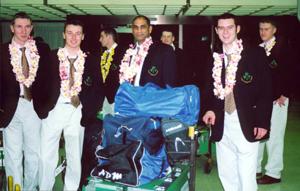 The garlands are out for a tired Irish Under l9 squad as they arrive at Colombo Airport.
The garlands are out for a tired Irish Under l9 squad as they arrive at Colombo Airport.
Back to the hotel and reality the phone was ringing and it was BBC NI wanting to know about the bomb. “Yes we were all OK. ” “No we didn’t hear it and please reassure everyone that we are locked up in a 5 star hotel and don ’ t want rescued! ”
Thursday 6 January
Our first official practice session at the Colombo Cricket Club where we were later scheduled to meet Australia. It wasn’t long before the conditions claimed their first victim-John Mooney retiring with heat stroke if not to the cool of the changing room at least to its shade. A clear lesson to all that the physio’s instructions on fluid intake, wearing hats and slapping on the sunscreen had to be observed.
Friday 7 January
We awoke to confirmation that a curfew had been placed on the whole of the city of Colombo and all eight teams were confined to the Hotel until at least 3p.m. Our scheduled match versus the combined Ananda/Nalanda Colleges was cancelled and a late afternoon practice arranged.
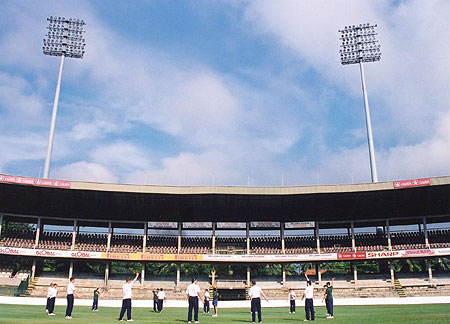 The Ireland team get in some pre-competition practice at the main Test stadium in Colombo.
The Ireland team get in some pre-competition practice at the main Test stadium in Colombo.
Saturday 8 January
A practice match against a combined Ananda/ Nalanda Colleges team and where are we playing? The Premadasa International Stadium, Sri Lanka’s premier Test venue, floodlights and all.
A wet pitch, a delayed start and a game restricted to 31 overs. A perfect start to the rigours of fielding in blazing heat. Seeing the players trooping off after fielding proved what an ordeal we had ahead of us. Ananda were bowled out in 30 overs for 102 with Jonathan Gardiner swinging and seaming the ball away to finish with 3 for 13 off 6 overs and Jordan McGonigle’s slow left arm claiming 3 for 17 off 7.
Our innings opened in bizarre fashion. The first ball was a wide while the third, a low leg-side full toss was middled by John Mooney only for him to see it brilliantly caught low and wide by backward square leg. The rest of the over included 6 more wides and the bowler finished the match with 1 over, 13 balls, 1 wicket for 7 runs! We only batted 20 overs before the gloom and thunderstorms came but in that time had managed to find ourselves 63 for 6 a situation that did not impress coach Rao. Officially ‘No Result’.
That night as we relaxed in the hotel foyer rumours started that we would be asked to play New Zealand the following day in a rescheduling of the practice matches. The Australians were due to arrive in the middle of the night after a 24-hour delay in Perth. It was thought that they may not wish to go straight into a match with New Zealand and if that were indeed the case then we would play New Zealand at the Premadasa Test Arena.
Sunday 9 January
We arrived at the ground to find the Ananda/ Nalanda schoolboys already changed and were told that Australia were playing New Zealand and that we could have a much gentler workout and replay our fixture of two days before. But wait- South Africa hadn’t got a match and thought we didn’t have one either so they approached the organisers asking could they play us. Of course you can-and the result was that the schoolboys were hurriedly thrown out of their dressing room and we awaited the arrival of South Africa never thinking that we would meet them later in the Tournament.
A delayed start meant that only a 44 over game was possible. We struck a deal with the opposition- we would bat first and should South Africa pass our score we would bowl on and give them 44 overs batting.
After an opening partnership of 28 from White and O'Prey we slumped to 42 for 6 against the pace of Senekal and the spin of My burgh. A flurry from Mooney (24) batting 6 took us to a total 92.
South Africa knocked off the runs in 22 overs for the loss of 3 wickets with only White, 1 for 7 off 5 overs, able to contain the free scoring. We bowled on as agreed and finished taking 3 more wickets and in a much-improved physical state. We were beginning to feel that we could get through 50 overs if we had to but the South African batting gave us an insight to the approach of the Test countries and their ability to punish anything slightly off length or line.
Monday 10 January
A morning practice session and then back to the hotel to prepare for the opening ceremony.
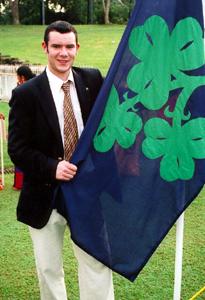 Ireland captain, Peter Shields, displays the Irish Cricket Union flag prior to the Opening Ceremony.
Ireland captain, Peter Shields, displays the Irish Cricket Union flag prior to the Opening Ceremony.
Scheduled to begin at 6.30 p.m., we were to travel to the nearby Sinhalese Sports Club at 4.00! This was to be our venue for the opening game next day versus Sri Lanka. It is the Sri Lankan Board HQ and was the Colombo Test Ground until the building of the Premadasa Stadium for the 1996 World Cup Tournament.
A lot of standing around waiting for the official photographs to be taken. No standing for the Honorary Secretary however who joined the dignitaries and diplomatic corps in the shade of the grandstand! More milling about preparing for the parade, keeping out of the way of the three huge elephants and troupes of local musicians and dancers. The parade itself, the captains lighting the Tournament flame, the ‘Riverdance’ interlude, the speeches-highly political in content, the firework display, the whole event was covered live on National Television. Spectacular indeed but the sight of an enormous swarm of huge Bats circling above us having been disturbed from their roost by the fireworks was chilling.
At the conclusion of the ceremony the Captains, Coaches and Managers attended a meeting where the Match referees, who were all former Sri Lankan Test players, the Umpires, Tournament Director and ICC officials all spelled out the regulations and their expectations for the Tournament. If we were in any doubt about it earlier it was clear now-this was the ‘Big-Time’.
Tuesday 11 January
Ireland versus Sri Lanka at S.S.C. Plan A win the toss, bat, post a total and throw the pressure on our hosts. Plan A quickly turned to Plan B as we struggled against pace and movement on a pitch which had some moisture in it. Should we have fielded first? The locals said yes, but our fear was that we would be in no state to chase a total after 50 overs in the sweltering heat.
Finding ourselves 9 for 3 and 27 for 5 in conditions favouring the ball it was Haire (39) and Mooney (34) who edged us towards respectability with a 67 run partnership. With McGerrigle hitting 3 sixes in his 23 we were somewhat relieved to reach 134. Our total was in fact better than some Test countries managed against Sri Lanka but posed no real threat against the pre-Toumament favourites and their best batsman Ian Daniels.
McGerrigle and Gardiner opened the bowling and after 5 overs the score was 46! Armstrong fared no better, his 2 overs going for 18. White gave the first indication that he could bowl with the degree of control required at this level, an ability that we were to rely on throughout.
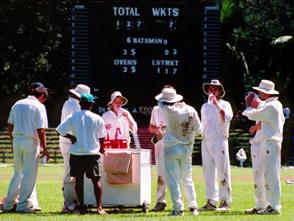 The high temperatures and humidity of Sri Lanka meant that the frequent drinks intervals were looked forward to most eagerly!
The high temperatures and humidity of Sri Lanka meant that the frequent drinks intervals were looked forward to most eagerly!
Daniels finished 72 not out as Sri Lanka breezed past us in the 24th over. What had our first match taught us? That runs could be scored against Test countries if you played positively and straight. That you couldn’t bowl off line or length and expect these batsmen to go easy on you. Would the lessons be learned?
Wednesday 12 January
A light morning practice at the C.C.C. Grounds where we were to meet Australia next day and a relaxing afternoon round the pool. Manager, Coach and physio went on a scouting mission to the local shopping centre in one of the swarm of ‘tuc-tucs’ that flood the streets. The wrong side of the road, up on the footpath weaving in and out of stationary traffic all accompanied by the sounding of the horn every five yards. A never to be forgotten or repeated experience.
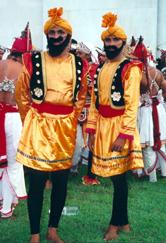 There was always plenty of local colour to enjoy during the team's stay in this most beautiful and fascinating country.
There was always plenty of local colour to enjoy during the team's stay in this most beautiful and fascinating country.
Thursday 13 January
Ireland versus Australia at C.C.C. Feeling that we could last the distance we asked Australia to bat. This was to be ‘our finest hour’. In front of the ICC World Development Officers we bowled Australia out. Having been 195 for 8 they scored 240, thanks to some poor length bowling in the last five overs. Conor Armstrong took 2 wickets in his opening over and took another in his fourth to have 3 for 9 at that stage. He finished with 3 for 23 and Jonathan Gardiner came back to take 3 late wickets. Jordan McGonigle will remember his first wicket, that of Australian Captain Michael Clarke. A member of the New South Wales Combined High Schools side which toured Northern Ireland two years ago, he was to miss the rest of the World Cup when called into the NSW state side, one to watch for.
Our reply got off to a shaky start at 4 for 2 and although we were never in the chase after that the batting of Joyce, Armstrong, Shields and Spelman meant that we were 170 for 7 going into the last over. At the end of the game Australian Coach Rod Marsh visited our dressing room to congratulate us on our performance and to offer some unpatronising words of encouragement
Friday 14 January
A light practice session in the morning followed by a trip to the local shopping mall under escort was the order of the day. An invitation for the Captain and Management to ‘Drinks’ at Westminster House, the official residence of the British High Commissioner gave a rare opportunity to meet the other teams socially and to get a glimpse of colonial living. Our Liaison Officer Dicky was the only casualty-assisted back to the coach a victim of the unmeasured tumblers of ‘Scottish Wine’.
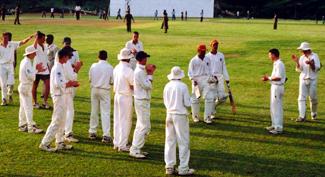 The Irish applaud the last Dutch batsmen off the field after Ireland's win in the Plate competition.
The Irish applaud the last Dutch batsmen off the field after Ireland's win in the Plate competition.
Saturday 15 January
Ireland versus Namibia at the Moors Ground. A win would confirm our third position in the group and would send us up-country to Nuwara Eliya where we could expect a cooler, more hospitable climate. Defeat would send us south to the southern tip of the island where the heat was even more unbearable than Colombo! A damp pitch, a delayed start, a reduction to 48 overs but we won the toss, put them in and got an early wicket. At 92 for 6 we were hoping to wrap things up for not much more than 120 but at this level there are plenty of late order batters who are more than capable. That should have come as no surprise to us but we were disappointed to allow Namibia to close at 186 for 7.
After our now customary poor start a partnership of 61 between Joyce who had opened for the first time and White now batting at four took us to 94 with both scoring apparently at will. From this position of comfort we lost White LB W and immediately after Joyce skied a Pull and we were 94 for 4. From then on it was problematical whether we would score the runs and even more unlikely that the match would be finished as the clouds which had brought downpours each night closed in. A check on the Duckworth-Lewis chart showed us ahead of our target then disaster, Mooney was bowled. Instantly we were behind and in the gathering gloom we needed 9 runs off what could be the last over. Ryan Haire was facing: 2-6-1 . We were 127 for 5, exactly the par score, the light was offered, accepted and we had the tie, which guaranteed third place.
We celebrated by having a night out at The Cricket Club Cafe, a themed restaurant -bar run by an Australian couple. While the walls are decorated mainly with Australian memorabilia we did manage to find a framed newspaper report of ‘that match’ at Sion Mills.
Sunday 16 January
A late breakfast, a mini shopping trip and our only day at the beach in the entire trip! Our plans for a quiet day were brought up short when Duncan Smythe stood on some coral. The physio’s probing with scissors and tweezers was nothing compared to what was to await him in hospital where the offending item was finally removed. Duncan’s comment returning to the hotel that he would never complain about anything ever again says all one needs to know about the restraint techniques that substitute for anaesthetic in the Sri Lankan health service!
Monday 17 January
An early start for the drive into the mountains. It was only about 130 miles but it was to take 10 hours! True, we did stop in Kandy for lunch at Lyons restaurant whose claim to fame is that it hosted a lunch for President Tito of Yugoslavia. We won’t be back either! Highlight of the journey was the other stop at Pine walla elephant orphanage. Hundreds of tourists gather at this river crossing to see the daily parade of a herd of some fifty elephants of all shapes and sizes being brought down to bathe.
The last few miles of the journey are the most spectacular and also the most hair-raising as the road zig-zags up mountainsides and along ravines with an absence of guard rails and a minimum of tarmac. Everywhere there were tea plantations; whole hillsides of plants such that it defied belief that each plant is plucked every seven days in what must be the most labour intensive of industries.
So it was with relief that we arrived at the aptly named Grand Hotel, an old style colonial hotel in the finest tradition of a bygone age. No pool here, but three snooker tables and a uniformed attendant in the snooker room to minister to your needs. The biggest surprise here was that Sammy Pavis had beaten us to it! Linfield’s legendary goal scorer had been the Sri Lankan National Snooker Coach and the Grand was his HQ. The attendant was in fact a member of the Sri Lankan snooker team, had been coached by ‘Sammy Save Us’ and was singularly unimpressed by our efforts.
Tuesday 18 January
A perfect summer’s day-a cloudless sky, a nice breeze and the temperature in the twenties. Perfect for us but not apparently for our ‘protectors’ who wore quilted jackets and complained how cold it was!
Our practice session at the Radella Grounds was cut short as the pitch on the square was dangerous. The whole square had been re-laid only 6 weeks earlier and was just dust. The match pitch for the next day was a little more solid but it too looked to be a ‘minefield’.
Wednesday 19 January
Ireland versus Holland at Dimbula Athletic Club. We arrived to find that the groundsman had flooded the pitch the previous night to try to bind it together and when the covers were removed it was apparent that there would be a delayed start as there were still damp patches visible. There was in fact a 2-hour delay and when we won the toss it was a case of batting on the pitch while there still was a pitch to bat on! Only Joyce looked to be able to cope in the conditions and even he went through a shaky patch in the twenties before completing our first fifty of the tournament. We were 119 for 3 and then lost 3 wickets for 10 runs to finish a disappointing 148 for 8 in our 40 overs.
A wicket in McGerrigle’s first over followed by White’s 8 overs for 13 tied the Dutch down and when Armstrong produced another double wicket over they were 48 for 5. At 80 for 7 with 10 overs to go we could even afford a little flurry from their tail before winning with some comfort as they were bowled out for 130.
Thursday 20 January
By now even the snooker room was losing its charm so lunch at the nearby Highland Hotel provided a welcome change of scenery. A visit to a tea factory was arranged-Poya, the monthly full moon holiday meant that it was difficult finding one open but eventually we arrived at Matekelle to find the Dimbula Grounds Curator was the factory manager. After a guided tour we had tea in his bungalow, a stark contrast to the homes of the plantation workers.
Friday 21 January
Ireland versus The Americas at Dimbula Athletic Club. In the days of the old International Youth Tournament you could rely on Bermuda to have three or four very good players and similarly with Canada. So put the best of Bermuda with the best of Canada, add a couple of good fast bowlers from Argentina and you could have a very handy outfit indeed.
Once again the toss went our way and we again took first use of the Dimbula pitch which was slowly improving as the days went by. Again we found ourselves unable to get a start, 11 for 2 with Joyce and O’Prey out. White and O’Brien took it to 73, Mooney chipped in with 22 and when White was eighth out at 156 Spelman’s 29 helped us to 183 all out with one over unused.
It was McGerrigle who made the initial breakthrough but it was Mooney ’ s burst including the opposition’s star batsman for a first ball duck that put the match beyond them. Again White’s off-spin was miserly, 8 overs for 13, but it was McGerrigle who came back to mop up the tail and to finish with 3 for 24 to Mooney’s 3 for 25.
A place in the semi-finals was now guaranteed prior to our final group game against the might of South Africa.
Saturday 22 January
The welcome prospect of a change of hotel was somewhat tempered by the knowledge that it lay at the end of an ‘exciting’ journey back down the mountains to Kandy. Once the all important brake fluid had been reassuringly topped up we were on our way to the Citadel Hotel. Occupying a spectacular setting on the banks of the river that circles the city it offered the kind of luxury that we had become accustomed to.
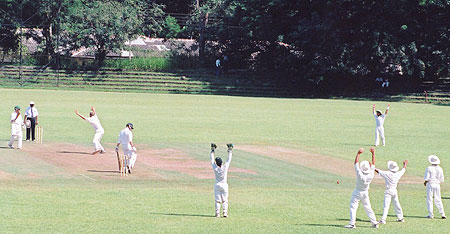 A vociferous, but unsuccessful, appeal in the game against South Africa.
A vociferous, but unsuccessful, appeal in the game against South Africa.
Sunday 23 January
Ireland versus South Africa at Kurunegala. The Welegedara Stadium is overlooked by a mini Ayres Rock that dominates one side of the ground and which reflects the afternoon sun into the stadium turning it into a furnace. It was in this setting that we were to produce our worst performance of the competition.
Wickets fell steadily throughout the innings and there was to be no middle order revival this time-78 all out in 30 overs. It was all over before lunch. South Africa scored the required runs in 13.4 overs and 50 minutes without losing a wicket. They scored half the runs in boundaries and their treatment of our pace attack was disdainful. A salutary lesson in batsmanship and the standards that we must aspire to.
Monday 24 January
Morning practice at another of Sri Lanka’s Test arenas, this time the Asgiriya Stadium in Kandy. We arrived to find the local school having its morning ‘break’ on the outfield. Athletics races were taking place and impromptu cricket matches in progress as we looked onto a scene unlikely to be witnessed at any English Test venue. It was a constant wonder to us throughout this trip that we seemed to be able to simply phone up the local Test ground, say we were coming to practise and be made most welcome. This says something about the Sri Lankan enthusiasm for the game and their desire to give everyone the opportunity to play whenever and wherever they can.
Tuesday 25 January
Ireland versus Bangladesh at Kurunegala. “They all come out playing shots, no matter what the score is! ” That was the assessment of our opponents by Paul Strang, the Zimbabwe Coach. How true that was to prove in a game, which swung to and fro more than once. The Bangladesh innings progressed in fits and starts as we seemed to take wickets in bursts. At 76 for 5 we were optimistic, then a partnership of 40 set us back only for McGerrigle to take wickets with successive balls to leave them in trouble at 117 for 7. But play shots they did and none better than Kalim whose 5 8 held their tail together and in the end took their score beyond our reach.
Our reply started slowly sparkled briefly and them stuttered to a halt leaving us well beaten. A single from O’Brien and a boundary from Joyce both in the third over were our only scoring shots in the first 7 overs! Nine maidens in the first fifteen overs when the fielding restrictions are in operation is hardly a recipe for success and although at one stage we were 55 for 2 we were to fall away chasing a mounting run rate. It was a tame end to a game that had started slipping away from us half way through the Bangladesh innings when we weren’t able to finish them off. We hadn’t made it to the Final, we were out of the Tournament, we were going home but we had no booking on the flight from Colombo and the London-Belfast tickets were now invalid due to our extended stay! Frantic faxes and phone calls were required to rebook flights and it was in a real act of faith that we made plans to check out of the Citadel.
Wednesday 26 January 3.00a.m.!
Some hadn’t bothered to go to bed. Some had spent hours on the fax and phone. Some had abandoned belongings to make room in their baggage for all the purchases gathered up in our three-week stay. All gathered in the foyer for the 3/4 hour drive to Colombo. We joined the early morning rush hour traffic on the outskirts of Colombo and called in at our first hotel the Oberoi to collect the ‘gifts’ we left behind while we were ‘up-country’ then on to the airport.
We had a VIP escorted passage ‘around’ the security scanners in the terminal and then on to the inevitable ‘trial’ of check-in. Our generous baggage allowance of 45 kilos was tested to the limit but with a bit of fast talking and a pocket calculator we were ready to spend the last of our rupees before boarding.
We shared the twelve-hour flight with the Dutch and the three Argentineans for whom Heathrow was only the halfway point in their journey home. We touched down in Heathrow at exactly 6 pm and wrestled our baggage from Terminal 4 to Terminal 1. Now came the act of faith-go to the British Midland desk and see if there were any tickets for us. Feherty Travel and Dessie McCall had not let us down, while we were in the air all had been arranged. We would get home that night!
It seemed strange to be met at the airport by parents you had last seen in Sri Lanka. We talked of how their journey home had been and of how we would all get together to relive the trip in photographs and video. That has yet to happen but the memories are still fresh enough to need no artificial stimulation.
Perhaps in the depths of winter our thoughts will turn to steamy days in a tropical climate and perhaps we will ask ourselves “what if …? ” But then that’s what winters are for!

